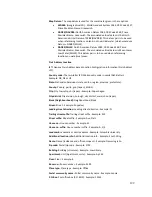
127
similar appliances supporting interactive voice services.
4.
Guest Voice Signaling
- For use in network topologies that require a
different policy for the guest voice signaling than for the guest voice media.
5.
Softphone Voice
- For use by softphone applications on typical data centric
devices, such as PCs or laptops.
6.
Video Conferencing
- For use by dedicated video conferencing equipment
and other similar appliances supporting real-time interactive video/audio
services.
7.
Streaming Video
- For use by broadcast or multicast based video content
distribution and other similar applications supporting streaming video
services that require specific network policy treatment. Video applications
relying on TCP with buffering would not be an intended use of this
application type.
8.
Video Signaling
- For use in network topologies that require a separate
policy for the video signaling than for the video media.
Policy:
Policy indicates that an endpoint device wants to explicitly advertise that the
policy is required by the device. It can be either “Defined” or “Unknown”.
Unknown
: The network policy for the specified application type is currently
unknown.
Defined
: The network policy is defined.
TAG:
TAG is an indication of whether the specified application type is using a tagged
or an untagged VLAN. It can be “Tagged” or “Untagged”.
Untagged
: The device is using an untagged frame format and as such does
not include a tag header as defined by IEEE 802.1Q-2003.
Tagged
: The device is using the IEEE 802.1Q tagged frame format.
VLAN ID:
VLAN ID is the VLAN identifier (VID) for the port as defined in IEEE 802.1Q-
2003. A value of 1 through 4094 is used to define a valid VLAN ID. A value of 0
(Priority Tagged) is used if the device is using priority tagged frames as defined by
IEEE 802.1Q-2003, meaning that only the IEEE 802.1D priority level is significant and
the default PVID of the ingress port is used instead.
Priority:
Priority is the Layer 2 priority to be used for the specified application type.
One of the eight priority levels (0 through 7).
DSCP:
DSCP is the DSCP value to be used to provide Diffserv node behavior for the
specified application type as defined in IETF RFC 2474. Contain one of 64 code point
values (0 through 63).
















































